Noguera Claudine
 |
Chercheure Emérite-CNRS
Team(s) Low-dimensional oxides |
Theoretical research in Condensed Matter:
- Many body problem (screening, plasmons, strongly correlated fermions)
- Structural instabilities in quasi one-dimensional solids
- Theoretical basis of EXAFS, photoemission, surface EXAFS, EXELFS, STM and AFM
- Numerical simulations (semi-empirical, first principles, Monte Carlo) and theoretical analysis of insulating oxide nano-objects, surfaces and ultra-thin films
- Theory and simulation of the nucleation and growth of pure and mixed oxides in an aqueous solution, with relevance to the natural environment.
Some Research Highlights
1) Polarity effects in low dimension:
Polar surfaces present an intrinsic electrostatic instability, which makes difficult their experimental or simulation study. However, an increasing number of works has recently been motivated by their interesting reactivity or wetting properties. They experience various stabilisation mechanisms: spontaneous metallization of the surface layers, non-stoichiometry, faceting, metal adsorption, dissociative adsorption of water, and this, as a function of external conditions (for example the oxygen partial pressure). In ultra-thin films, we have pointed out two new mechanisms of polarity compensation.
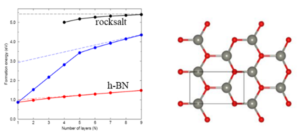
The first one is the possibility of a complete change of structure. (J. Goniakowski, C. Noguera, L. Giordano, Phys. Rev. Letters 93 (2004) 215702). Exemplified in the prototypical case of MgO(111) ultra-thin films, it shows that, along that polar orientation, the rocksalt structure is unstable with respect to an hexagonal Boron Nitride one. The stability of the latter is promoted by its charge neutral (0001) graphene-like layers. Ultra-thin ZnO(0001) films also possess this non-polar ground state.
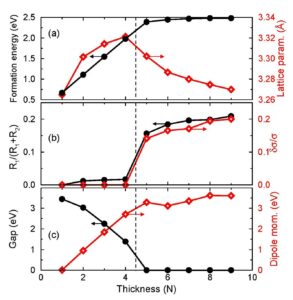
MgO (111) unsupported film properties: (a) in-plane lattice parameter and formation energy, (b) rumpling R1/(R1 + R2) and relative surface charge δσ/σ, (c) gap G and dipole moment P.
The second peculiar feature of ultra-thin polar films is the possibility of an uncompensated state at low thickness. We highlighted it by analysing the electronic properties of MgO(111) thin films in the ZnS-type state represented in blue in the above figure (J. Goniakowski, C. Noguera, L. Giordano, Phys. Rev. Letters 98, 205701 (2007)). Below a critical thickness, the oxide gap remains open and there is no charge exchange between the two terminations. A non-zero dipole moment exists but it is too small to close the gap. Above the critical thickness, electronic and structural properties converge towards the bulk-like ones. Such so-called under-critical regime was also found in LaAlO3 films deposited on SrTiO3(001).
2) Nanopyramidal Reconstruction of Cu2O(111): A Long-Standing Surface Puzzle Solved by STM and DFT:
Despite the importance of cuprous oxide for industrial applications, the precise structure of its most stable reconstructed surface remains unknown. By a combination of high-resolution scanning tunneling microscopy (STM) measurements and simulations based on a density functional theory-HSE approach, we challenge the previous interpretations of the Cu2O(111) (√3 × √3 )R30° surface reconstruction based on the removal of one-third of the undercoordinated surface oxygen atoms. We show that these models do not satisfy the shamrock-type features found by STM, that is, their position in the Cu−O ring centers, the orientation toward the surface Ocus atoms, and the topographic height in the STM images. Moreover, they are thermodynamically unstable with respect to moving the vacancy subsurface, a property not recognized before, which seems specific to the Cu2O(111) surface. We propose a nanopyramidal model of the ( √3 ×√ 3 )R30° surface reconstruction, which is free from all these shortcomings. The shamrock protrusions seen in STM are formed by three copper adatoms located at the center of the Cu−O rings and capped by an oxygen atom. This structure profoundly differs from the existing models of the Cu2O(111) surface and would change common perceptions on its reactivity. (Gloystein, N. Nilius, J. Goniakowski, and C. Noguera, J. Phys. Chem. C 2020, 124, 26937−26943; J. Phys.: Condens. Matter 33 (2021) 484001)
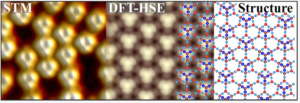
3) Structural diversity of Al2O3 ultra-thin films:
Using a combined tight-binding/DFT genetic algorithm (GA) approach, we have identified particularly stable Al2O3 θ(100)-type films along with a host of novel stable thin film structures. Several of these correspond to cuts from relatively high energy bulk structures, e.g. dehydrated boehmite, pseudo-CaIrO3, defective rocksalt and LuMnO3, which are not commonly associated with alumina. DFT calculations allow to rationalize this stability reversal with respect to α-Al2O3 in terms of low surface energies compared to α(0001) and to identify the underlying mechanisms: breaking a low density of relatively weak Al–O bonds, filling of Al surface vacancies, and polarity-induced relaxation of the whole film. With the same approach, we have also explicitly demonstrated that ultra-thin θ(100)-type films correspond to the structural ground state of alumina supported on the (2 × 1)-NiAl(100) substrate. (M. Vanden Bossche, C. Noguera, J. Goniakowski, Nanoscale 2020, 12, 6153; Nanoscale 2021, 13, 19500)
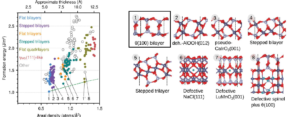
Calculated formation energies with respect to bulk α-Al2O3 for the thin films obtained with the 2D-GA.
4) Nanoscale effects in oxide/metal hetero-epitaxy:
The growth mode of strained epitaxial films relies on the interaction strength, the lattice matching, and the mechanical response of the system. With a combination of experiments and simulations we highlight the existence of a small size regime in MgO nano-islands deposited on Ag(100).
At the onset of the MgO film growth, the average in-plane Mg-Mg distance determined by EXAFS, is highly contracted, not only with respect to that of the bulk oxide but even relative to the Ag-Ag distance, while beyond 5 ML, they progressively tend toward the bulk MgO value. This observation does not match the current view of a pseudomorphic growth of MgO/Ag(100) films. Atomistic simulations relying on a semiempirical Hartree-Fock approach indeed highlights two size regimes and highly inhomogeneous relaxation effects. For island sizes below 4nm, the Mg-Mg distances in the island center display a progressive increase up to a value close to that of unsupported islands. Above this size, the maximum transforms into a minimum corresponding to the Ag-Ag value, meaning the growth of a pseudomorphic zone in the island center.
In the small size regime, despite the largest adhesion and the smallest mismatch, the islands are thus the least distorted by the substrate. We assign this unexpected behavior to the enhanced island stiffness which makes the cost of elastic distortion prohibitive compared to the associated gain of MgO-Ag interaction energy. (G. Cabailh, J. Goniakowski, C. Noguera, J. Jupille, R. Lazzari, J. Li, P. Lagarde, and N. Trcera, Phys. Rev. Mat. 3, 046001 (2019)).
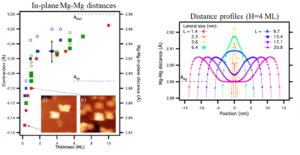
Left: EXAFS determination of the Mg-Mg distance contraction with respect to the bulk value. Right: calculated Mg-Mg distance profiles in 4 ML-thick islands of increasing lateral size, recorded from the center of the island.
5) Defects and Domain Boundaries in a 2D honeycomb monolayer :
Two-dimensional materials with a honeycomb lattice, such as graphene and hexagonal boron nitride, often contain local defects in which the hexagonal elements are replaced by four-, five-, seven-, and eight-membered rings. An example is the Stone–Wales (S–W) defect, where a bond rotation causes four hexagons to be transformed into a cluster of two pentagons and two heptagons. A further series of similar defects incorporating divacancies results in larger structures of non-hexagonal elements. By a combination of scanning tunneling microscopy (STM) and density functional theory (DFT) modeling we have investigated the structure and energetics of S–W and divacancy defects in a honeycomb (2 × 2) Ti2O3 monolayer grown on an Au(111) substrate. The epitaxial rumpled Ti2O3 monolayer is pseudomorphic and in a state of elastic compression. As a consequence, divacancy defects, which induce tension in freestanding films, relieve the compression in the epitaxial Ti2O3 monolayer and therefore have significantly lower energies when compared with their freestanding counterparts. Our results demonstrate the capacity of the substrate to significantly influence the energetics, and hence favor vacancy-type defects, in compressively strained 2D materials. (Shuqiu Wang, a Xiao Hu, Jacek Goniakowski, Claudine Noguera and Martin R. Castell, Nanoscale, 2019, 11, 2412; Adv. Mater. Interfaces 2022, 2102213)
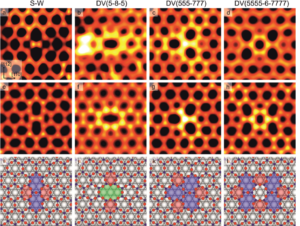
Defect structures in Ti2O3 honeycomb. Experimental STM data (a–d), and corresponding DFT simulations (e–h) of S–W, DV(5-8-5), DV(555-777) and DV(5555-6-7777) defects
Domain boundaries (DBs) are rare in 2D van-der-Waals bonded materials where the grains can easily move. However, this movement is not possible in 2D materials that have a strong epitaxial relationship with their substrate such as the M2O3 (2 × 2) honeycomb monolayers on noble metal (111) supports. Involving experimental and theoretical investigations, four main DBs have been observed in a monolayer of Ti2O3 supported on Au(111) and their atomic structures have been solved. The DB formation energies explain why some DBs are more frequently observed than others. The strong epitaxial constraint from the Au(111) substrate stabilizes some unique Ti2O3 monolayer DB structures that are not observed in vdW-bonded 2D materials.
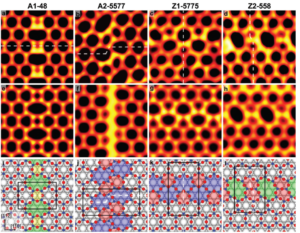
Domain boundary structures in the Ti2O3 honeycomb monolayer. a–d) Experimental STM data and e–h) corresponding DFT image simulations of A1–48, A2–5577, Z1–5775, and Z2–558 structures. i–l) Atomic models including the Au(111) substrate atoms with Ti atoms in blue, O atoms in red, and Au atoms in gray. A and Z stand for armchair and zigzag oriented DBs.
6) Improving adhesion at weakly interacting metal/oxide interfaces
The control of adhesion at metal/oxide interfaces is of key importance in modern applications, whenever three-dimensional metal clusters or two-dimensional metal overlayers are to be synthesized on an oxide support. By focusing on the zinc/alumina and zinc/silica systems, we have addressed one of the long-standing issues in this context, which is the poor wetting of wide band gap oxides by noble and post-transition metals. It has recently been recognized to have detrimental industrial consequences for the adhesion of anticorrosive zinc coatings to new high strength steel grades.
Both experimental and computational results have shown that an activated reaction of the metal with the OH-covered surface, followed by hydrogen desorption, produces dispersed interfacial moieties involving both oxidized Zn species and under-coordinated oxygen ions that lead to a significant improvement of adsorption/adhesion characteristics on the hydroxylated surface. In particular, the key role of interfacial under-coordinated anions, remnants of the hydroxylation layer, wa highlighted, pointing to a general mechanism by which surface hydroxylation appears as a promising route toward a systematic improvement of wide band gap oxide wetting by metals. (H−L Thi Le, R. Lazzari, J. Goniakowski, R. Cavallotti, S. Chenot, C. Noguera, J. Jupille, A. Koltsov, and JM. Mataigne J. Phys. Chem. C 2017, 121, 11464-11471)
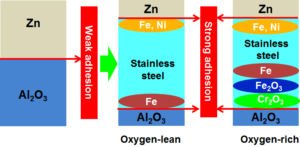
We have performed a theoretical study on the effect of realistic multicomponent metal buffers on the adhesion strength of a model α-alumina (0001)|zinc interface. Relying on results of ab initio calculations on relevant individual oxide|oxide, oxide|metal, and metal|metal interfaces (separation and interface energies), we determine by Monte Carlo simulations the thermodynamically preferred sequence of components in a multicomponent buffer, as a function of buffer composition and oxygen conditions. We find that stainless steel buffers considerably enhance the overall strength of the alumina|zinc interface. (H-L Thi Le, J. Goniakowski, C. Noguera, A., JM Mataigne. Journal of Physical Chemistry C, 2016, 121 (45) 25143-25151)
7) Fundamentals of cation mixing in oxides
While cation replacement has long been used to tailor the functionalities of oxide compounds, the growing industrial demand for nanoscale materials nowadays requires precise atomic scale characterization and understanding of the cation distribution. We have performed a series of theoretical studies of cation mixing in bulk corundum transition metal oxides MM’O3 and their 2D analogues of honeycomb structure, with the goal of deciphering the microscopic mechanisms responsible for mixing (preference for neighboring M-M’ pairs) or phase separation (preference for neighboring M-M or M’-M’ pairs). In most cases, the stabilization of mixed structures is associated to changes of cationic oxidation state, either due to a redox reaction between the cations or to an electron exchange with the substrate. (J. Goniakowski, C. Noguera, Phys. Rev. Mat. 2, 085001 (2018) ; J. Phys. Chem. C 2019, 123, 7898−7910; J. Phys. Chem. C 2019, 123, 9272−9281; J. Phys. Chem. C 2020, 124, 8186−8197; J. Phys.: Condens. Matter 34 (2022) 034002).
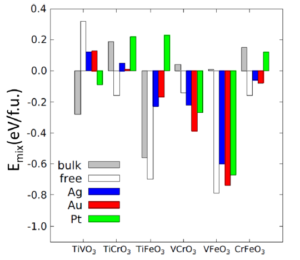
Mixing energies in the series of six mixed HC oxides. Results for bulk, frestanding, Ag-, Au-, and Pt-supported cases are represented in gray, white, blue, red, and green, respectively. Negative mixing energies indicate favorable mixing.
We have performed a successful synthesis of a two-dimensional (V,Fe)2O3 alloy supported on Pt(111) which is thermodynamically stable at realistic temperatures and for Fe contents up to 50%. Combining fine atomic resolution STM experiments and DFT calculations, we have evidenced an unequivocal preference for the formation of mixed V−Fe nearest-neighbor pairs, to a large extent driven by cation−cation electrostatic interactions. Moreover, Monte Carlo simulations have enabled an in-depth rationalization of the observed cation distribution in the honeycomb lattice. The V−Fe mixing is restricted to 2D systems and not observed in the corresponding bulk systems, and is closely related to a change in vanadium oxidation state resulting from the interaction with the substrate. The flexibility of composition, of the distribution of cations and of their charge state provides levers to tune the properties of such two-dimensional oxide alloys and may thus enhance their potential for applications. (Wemhoff, PI; Nilius, N; Noguera, C; Goniakowski, J, J. Phys. Chem. C 2022, 126, 5070−5078).
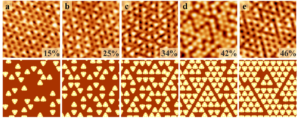
Topographic STM images (UB = 1.5 V; 5 × 5 nm2) (a) and snapshots of Monte Carlo simulations (b) of mixed (V,Fe)O3 honeycomb oxides on Pt(111) at increasing Fe concentrations x.
Publications
Books:
- C. Noguera: ‘Physique et Chimie des Surfaces d’Oxydes’ collection Alea CEA-Eyrolles (1995)
- C. Noguera: “Physics and Chemistry at Oxide Surfaces” Cambridge University Press (1996)
- F. P. Netzer and C. Noguera: ‘Oxide thin films and nanostructures’ Oxford University Press (2021)
Latest publications:
2022
- Mixing properties of Al2O3(0001)-supported M2O3 and MM’O3 monolayers (M, M ‘ = Ti, V, Cr, Fe). Noguera, C and Goniakowski, J, Phys.: Condens. Matter 34 03400 (2022)
- Two-Dimensional Oxide Alloys Probed at the Atomic Level: (V,Fe)2O3 Honeycomb Monolayers on Pt(111). Wemhoff, PI; Nilius, N; (…); Noguera C., Goniakowski, J, 2022 | JOURNAL OF PHYSICAL CHEMISTRY C 126 (10) , pp.5070-507)
- Epitaxially Constrained Grain Boundary Structures in an Oxide Honeycomb Monolayer. Wang, SQ; Hu, X; Noguera C., Goniakowski, J, (…); Castell, MR, ADVANCED MATERIALS INTERFACES 2022, 2102213
- Structure and Stoichiometry Self-Organization in a Mixed Vanadium-Iron Oxide Honeycomb Film on Ru(0001). Piotr Igor Wemhoff, Claudine Noguera, Jacek Goniakowski, and Niklas Nilius. Accepted Journal of Physical Chemistry C (November 2022).
2021
- Size effect in two-dimensional oxide-on-metal catalysts of CO oxidation and its connection to oxygen bonding: An experimental and theoretical approach Zhang, K; Li, LF; Goniakowski J., Noguera C. (…); Shaikhutdinov, S, 2021 | JOURNAL OF CATALYSIS 393 , pp.100-106
- Modelling the precipitation of nanoparticles in a closed medium in the presence of seeds: Application to amorphous silica synthesis Noguera, C; Fritz, B; (…); Lemarchand, D, 2021 | JOURNAL OF COLLOID AND INTERFACE SCIENCE 601 pp.843-852
- Structural characteristics of Al2O3 ultra-thin films supported on the NiAl(100) substrate from DFTB-aided global optimization Van den Bossche, M; Goniakowski, J and Noguera, C , 2021 | NANOSCALE 13 (46) , pp.19500-19510
- Termination-dependent electronic structure and atomic-scale screening behavior of the Cu2O(111) surface Gloystein, A; Nilius, N; (…); NogueraC. Goniakowski, J, 2021 | JOURNAL OF PHYSICS-CONDENSED MATTER 33 33 484001
2020
- Understanding the structural diversity of freestanding Al2O3 ultrathin films through a DFTB-aided genetic algorithm Van den Bossche, M; Noguera, C and Goniakowski, J, 2020 | NANOSCALE 12 (10) , pp.6153-6163
- Properties of Metal-Supported Oxide Honeycomb Monolayers: M2O3 and MM’O3 on Me(111) (M, M ‘ = Ti, V, Cr, Fe; Me = Ag, Au, Pt) Goniakowski, J and Noguera, C, 2020 | JOURNAL OF PHYSICAL CHEMISTRY C 124 (15) , pp.8186-8197
- Optimization of Anticorrosive Zinc Coatings: Tuning the Adhesion of Zinc/Silica Contact by Interfacial Ternary Oxide Formation Baima, J; Goniakowski J., Noguera C.; (…); Mataigne, JM, 2020 | JOURNAL OF PHYSICAL CHEMISTRY C 124 (17) , pp.9337-9344
- Oxide at the Al-rich Fe85 Al0.15 (110) surface, Dai, ZB; Alyabyeva, N; Goniakowski J., Noguera C.; (…); Lazzari, R, 2020 | PHYSICAL REVIEW MATERIALS 4 (7) 074409
- Theoretical study of metal/silica interfaces: Ti, Fe, Cr and Ni on beta-cristobalite Baima, J; Le, HLT; Goniakowski J., Noguera C. ; (…); Mataigne, JM, 2020 | PHYSICAL CHEMISTRY CHEMICAL PHYSICS 22 (37) , pp.21453-21462
- Nanopyramidal Reconstruction of Cu2O(111): A Long-Standing Surface Puzzle Solved by STM and DFT Gloystein, A; Nilius, N; (…); Noguera, C, 2020 | JOURNAL OF PHYSICAL CHEMISTRY C 124 (49) , pp.26937-26943
2019
- (0001) Interfaces between M2O3 corundum oxides (M = Al, Ti, V, Cr, Fe). Le, HLT; Goniakowski, J and Noguera, C, 2019 | SURFACE SCIENCE 679 , pp.17-23
- Influence of the support on stabilizing local defects in strained monolayer oxide films Wang, SQ; Hu, X; Goniakowski J., Noguera C.;(…); Castell, MR, 2019 | NANOSCALE 11 (5) , pp.2412-2422
- Intrinsic Properties of Pure and Mixed Monolayer Oxides in the Honeycomb Structure: M2O3 and MM’O3 (M, M’ = Ti, V, Cr, Fe) Goniakowski, J and Noguera, C, 2019 | JOURNAL OF PHYSICAL CHEMISTRY C 123 (13) , pp.7898-7910
- Properties of M2O3/Au(111) Honeycomb Monolayers (M = Sc, Ti, V, Cr, Mn, Fe, Co, Ni) Goniakowski, J and Noguera, C, 2019 | JOURNAL OF PHYSICAL CHEMISTRY C 123 (14) , pp.9272-9281
- Understanding nanoscale effects in oxide/metal heteroepitaxy Cabailh, G; Goniakowski J., Noguera C.; (…); Trcera, N Apr 29 2019 | PHYSICAL REVIEW MATERIALS 3 (4)
- Surface thermodynamics of silicate compounds: the case of Zn2SiO4(001) surfaces and thin films Baima, J; Goniakowski J., Noguera C.; (…); Mataigne, JM, 2019 | PHYSICAL CHEMISTRY CHEMICAL PHYSICS 21 (24) , pp.13287-13295
- Atomic and electronic structure of an epitaxial Nb2O3 honeycomb monolayer on Au(111) Wang, SQ; Goniakowski J., Noguera C.; (…); Castell, MR, 2019 | PHYSICAL REVIEW B 100 (12)
2018
- Solid Solution/Exsolution Noguera, C and Fritz, B 2018 | ENCYCLOPEDIA OF GEOCHEMISTRY: A COMPREHENSIVE REFERENCE SOURCE ON THE CHEMISTRY OF THE EARTH , pp.1352-1359
- Temperature-dependent phase evolution of copper-oxide thin-films on Au(111) Moller, C; Fedderwitz, H; Goniakowski J., Noguera C.; Nilius, N, 2018 | PHYSICAL CHEMISTRY CHEMICAL PHYSICS 20 (8) , pp.5636-5643
- Structural, electronic and adhesion characteristics of zinc/silica interfaces: ab initio study on zinc/beta-cristobalite Le, HLT; Goniakowski J., Noguera C.; (…); Mataigne, JM, 2018 | PHYSICAL CHEMISTRY CHEMICAL PHYSICS 20 (9) , pp.6254-6263
- Effects of surface hydroxylation on adhesion at zinc/silica interfaces Le, HLT; Goniakowski J., Noguera C.; (…); Mataigne, JM, 2018 | PHYSICAL CHEMISTRY CHEMICAL PHYSICS 20 (22) , pp.15581-15588
- Properties of mixed transition metal oxides: MM’O3 in corundum-type structures (M, M ‘ = Al, Ti, V, Cr, and Fe) Le, HLT; Goniakowski, J and Noguera, C, 2018 | PHYSICAL REVIEW MATERIALS 2 (8)
- Theoretical analysis of the kinetics of precipitation of lizardite and magnesite from olivine alteration Fritz, B; Clement, A; (…); Noguera, C, 2018 | CHEMICAL GEOLOGY 497 , pp.18-26
2017
- Ha−Linh Thi Le, R. Lazzari, J. Goniakowski, R. Cavallotti, S. Chenot, C. Noguera, J. Jupille, A. Koltsov, and JM Mataigne :Tuning Adhesion at Metal/Oxide Interfaces by Surface Hydroxylation J. Phys. Chem. C 2017, 121, 11464-11471
- Doudin, S. Pomp, M. Blatnik, R. Resel, M. Vorokht, J. Goniakowski, C. Noguera, F.P. Netzer, S. Surnev Epitaxial NiWO4 films on Ni(110): Experimental and theoretical study of surface stability SURFACE SCIENCE Volume: 659 Pages: 20−30, 2017
- Goniakowski and C Noguera A Theoretical Introduction to Oxide Ultrathin Films: Intrinsic Finite Size Effects and Interaction With a Metallic Substrate Encyclopedia of Interfacial Chemistry: Surface Science and Electrochemistry, 2017, Elsevier http://dx.doi.org/10.1016/B978−0−12−409547−2.12888−4,
2016
- Pan, QS; Weng, XF ; Chen, MS; Giordano, L ; Pacchioni, G; Noguera, C ; Goniakowski, J ; Shaikhutdinov, S ; Freund, HJ. Enhanced CO Oxidation on the Oxide/Metal Interface: From Ultra−High Vacuum to Near−Atmospheric Pressures. CHEMCATCHEM 7, 2620−2627, sept 2015
- Claudine Noguera, B. Fritz, A. Clement. Kinetics of precipitation of non−ideal solid−solutions in a liquid environment. Chemical Geology, Elsevier, 2016, 431, pp.20−35.
- Ha−Linh Thi Le, Jacek Goniakowski, Claudine Noguera, Alexey Koltsov, Jean−Michel Mataigne. First−Principles Study on the Effect of Pure and Oxidized Transition−Metal Buffers on Adhesion at the Alumina/Zinc Interface. Journal of Physical Chemistry C, American Chemical Society, 2016, 120 (18).
- Jacek Goniakowski, Claudine Noguera. Insulating oxide surfaces and nanostructures. Comptes Rendus Physique, Elsevier Masson, 2016, Physique de la matière condensée au XXIe siècle: l’héritage de Jacques Friedel, 17 (3−4), pp. 471−480.
- Niklas Nilius, Hanna Fedderwitz, Boris Groß, Claudine Noguera, Jacek Goniakowski. Incorrect DFT−GGA predictions of the stability of non−stoichiometric/polar dielectric surfaces: The case of Cu2O(111). Physical Chemistry Chemical Physics, Royal Society of Chemistry, 2016, 18, 6729
- Sponza, Lorenzo; Goniakowski, Jacek; Noguera, Claudine. Confinement effects in ultrathin ZnO polymorph films: Electronic and optical properties. PHYSICAL REVIEW B93,195435, 2016
- Noguera, Claudine; Goniakowski, Jacek. Electrostatics and Polarity in 2D Oxides. Edited by: Netzer, FP; Fortunelli, A OXIDE MATERIALS AT THE TWO−DIMENSIONAL LIMIT Book Series: Springer Series in Materials Science Volume: 234 Pages: 201−231, 2016
- Improving Adhesion at the Alumina/Zinc Interface by Stainless Steel Buffers Le, HLT; Goniakowski, J; Noguera C.; (…); Mataigne, JM, 2017 | JOURNAL OF PHYSICAL CHEMISTRY C 121 (45) , pp.25143-25151
2015
- Canbek, Z. Cansu; Cortes−Huertos, Robinson; Testard, Fabienne; et al., CRYSTAL GROWTH & DESIGN,15, 3637−3644, Août 2015 “Twinned Gold Nanoparticles under Growth: Bipyramids Shape Controlled by Environment”
- Cortes−Huerto, Robinson; Goniakowski, Jacek; Noguera, Claudine, PHYSICAL CHEMISTRY CHEMICAL PHYSICS 17,: 6305−6313, 2015 “Role of the environment in the stability of anisotropic gold particles”
- Güller, F.; Llois, A. M.; Goniakowski, J.; Noguera C., PHYSICAL REVIEW B 91, 075407, 2015 “Prediction of structural and metal−to−semiconductor phase transitions in nanoscale MoS2, WS2, and other transition metal dichalcogenide zigzag ribbons”
- Goniakowski, C. Noguera, J. Phys. Condensed Matter, 26, 485010, 2014 “Conditions for electronic reconstruction at stoichiometric polar/polar interfaces”
- Noguera, C.; Fritz, B.; Clement, A., JOURNAL OF COLLOID AND INTERFACE SCIENCE, 448, 553−563, 2015 “Precipitation mechanism of amorphous silica nanoparticles: A simulation approach”
- Prada, L. Giordano, G. Pacchioni, C. Noguera and J. Goniakowski, J. Chem. Phys. 141, 144702 , 2014 “Properties of Pt−supported iron oxide ultra−thin films: Similarity of Hubbard−corrected and hybrid density functional theory description”
- Sponza, Lorenzo; Goniakowski, Jacek; Noguera, Claudine, PHYSICAL REVIEW B 91, 075126, 2015 “Structural, electronic, and spectral properties of six ZnO bulk polymorphs”
- Wu, Chen; Castell, Martin R.; Goniakowski, J.; Noguera, C. PHYSICAL REVIEW B91, 155424, 2015 , “Stoichiometry engineering of ternary oxide ultrathin films: BaxTi2O3 on Au(111)”
CV
Education :
Ecole Normale Supérieure (1971-1975)
Agregation in Physique (1975)
Master thesis in Solid State Physics, Orsay, February 1975
PhD in Solid State Physics, Orsay, January 1981
Status :
– Associate Professor, University Paris 11, Orsay : 1975-1986
– CNRS Researcher: 1986-
-Chargée de Recherches 1ère classe : 1986
-Directeur de Recherches de 2ème classe : 1991
-Directeur de Recherches de 1ère classe : 2002
-Directeur de Recherches classe exceptionnelle : 2012
-Directeur de Recherches emeritus : 2018-
Responsibilities:
President of ECOS-Sud committee (2001-2004)
Director of Groupe de Physique des Solides (Paris) (2002-2004)
Director of Institut des Nanosciences de Paris (INSP) (2005-) French Director of the International Franco-Argentinian Nanociences Laboratory (LIFAN) (2009-2013)
President of the Advanced Grant ERC panel PE4 (2009, 2011, 2013)

